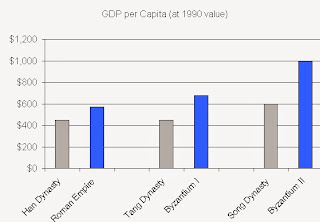There has been a lot of hubbub in recent years about associating the economic rise of the People's Republic of China with their past historical prosperity. The thinking goes that the Middle Kingdom, once a great and prosperous empire will become the economic top dog simply because it was once. That there is something intrinsic and unstoppable within the Chinese polity and society driving it towards becoming the world's economic superpower rooted in its past performance. This mainly comes out from the historical-economic data that was put forth by economist Angus Maddison and that has been rehashed and misread throughout and has spawned graphs (like this one) that keep being misinterpreted.
Many analysts fail to properly take into account China's uniqueness in size and scope and compare its performance with similar past societies. True, there aren't many that fit, but there are a few which did (and do) rival China's size and hegemonic presence and for which there is ample material to delve into. Namely, we can compare the Han Dynasty and the Roman Empire (until 200 A.D.), the Tang Dynasty, the Song Dyansty and the Eastern Roman Empire and the modern day People's Republic of China and the European Union. All relatively speaking successor states to one another (I would have liked to add a comparison to the Carolingian Empire but I cannot find solid data)
Although I will use Maddison's own work, revisions of his calculations done by Elio Lo Caslio and Paolo Malanima put the GDP per capita of the Roman Empire at an average of U$1,000 and even U$1,400 for the core Italian provinces so between two to three times higher than their Han counterpart (compare that to the below figures).
According to Maddison, the GDP per Capita of the Song and Tang dynasties were of U$450 while that of the Roman Empire was of U$540. According to a study conducted by economist Branko Milankovic of the World Bank, the GDP per Capita of Byzantium was between U$680 and U$770, reaching a peak of U$1,000 per capita in the 10th century, versus U$600 for the Song Dynasty. The GDP per Capita at PPP for the EU and the PRC respectively are of U$ 29,729 and U$7,240.
So please tone down the jingoistic rhetoric on China's inevitable rise. If you really believe that China's past economic clout is inexorably conductive of its current performance, then you will also need to accept that the Chinese people will always be poorer. And wonder why Italy and Turkey don't take over the world.
Maddison, Angus (2007): "Contours of the World Economy, 1–2030 AD. Essays in Macro-Economic History", Oxford University Press, ISBN 978-0-19-922721-1, pp. 43–47; 50, table 1.10; 54, table 1.12
Milanovic, Branko (2006): "An Estimate of Average Income and Inequality in Byzantium around Year 1000", Review of Income and Wealth, Vol. 52, No. 3, pp. 449–470

No comments:
Post a Comment